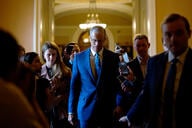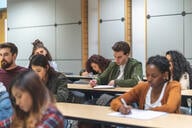You have /5 articles left.
Sign up for a free account or log in.
As a Nobel Prize-winning physicist, Carl Wieman could probably get away with being a mediocre teacher. Yet he’s devoted much of his career to improving the ways colleges and universities teach science, in his own classrooms and in one of the grandest experiments of his life: the multicampus Science Education Initiative.
Wieman’s new book chronicles the latter effort and makes a strong, evidence-based case for pursuing broad changes in science instruction: out with lectures and in with active learning. It’s also an easily digested how-to guide for interested parties, including deans, department chairs and other faculty members. The project has major implications for administrators, too. Spoiler alert: if institutions want better science teaching, they have to value it alongside research.
“The Science Education Initiative showed that it is possible for large, research-intensive science departments to make major changes in their teaching,” says Wieman, a professor of physics and education at Stanford University. “Most faculty adopted innovative research-based methods, and as a result experienced teaching as a far more rewarding activity than they had found it to be using traditional lectures. Their students attend class more and are far more interested in learning the subjects and benefiting from instructors’ expertise.”
Moreover, he concludes, “Advancing the craft of teaching has become much more of a shared goal and focus of collaborative intellectual activity in these departments, with faculty sharing methods and results and seeking out ideas from others of novel ways to solve instructional challenges.”
Faculty members did find learning to teach anew takes time, he wrote, but “given suitable support, the time investment is not much greater than that required to create a new course. The results are perceived to be worth the effort.”
Improving How Universities Teach Science: Lessons From the Science Education Initiative (Harvard University Press) details Wieman’s experiences leading the program across 13 science departments at the University of Colorado at Boulder and the University of British Columbia. Wieman used to teach at both campuses, and his goal to was to adopt, at scale, the most promising research-based approaches to science teaching.
Why?
After many years of doing research on bettering undergraduate science education, Wieman says, “I became convinced that it was time for broad-based change.” Despite overwhelming evidence that “new research-based methods were superior to the lecture instruction found in most college science classrooms,” he wrote, professors “were mostly unaware of this superiority, even in the situations where active research on improving science education was talking place within their own departments.”
Wieman sums up the literature on science education like this: no one develops a true understanding of such a complex field by passively listening to explanations alone. Instead, they must “actively construct their own understanding via a process of mentally building on their prior thinking and knowledge” through what’s been called “effortful study.” Experts, eventually, have not only factual knowledge but distinctive mental organizational structures and problem-solving skills. They also have the metacognitive wherewithal to evaluate and correct their own thinking processes.
While there’s a growing need for technical literacy and skills across the work force and in public policy decisions, Wieman says too many students today are learning that “‘science’ is a set of facts and procedures that are unrelated to the workings of the world and are simply to be memorized without understanding, and they learn to ‘solve’ science problems by memorizing recipes that are of little use other than passing classroom exams.”
What to do? Wieman devised a six-year plan to get active learning to the masses, via new incentives for good teaching and science education specialists embedded within each participating department at Colorado and British Columbia. Wieman and his collaborators tried to operate within the typical financial and organizational constraints of the contemporary research university, so that their project -- if successful -- could at least inspire change (if not exactly be replicated) on additional campuses. So it wasn’t overwhelmingly costly and it didn’t supersede the departmental structure that Wieman concludes is necessary because the human brain can only be expert in so many fields.
What Should Students Learn? What Are They Learning? How Will They Learn Better?
At the heart of the initiative was a course transformation process, guided by three questions: What should students learn, what are students learning and which instructional practices will improve student learning? Education specialists worked with individual faculty members to help them rethink their courses and, at the same time, impart to them new teaching methods, in accordance with the principles of the initiative. Active learning techniques include worksheet-based activities, clickers to answer questions in real time, whole-class discussions and solo and paired work. Specialists working with small groups of faculty members at the same time was found to be a less successful approach.
Each campus had central program oversight, to pursue and make decisions about funding, give feedback on how to improve departmental results and to train education specialists; the specialists learned not only pedagogical skills but also how to work with faculty members. Data collection on student achievement initially proved more difficult than expected, largely because there was little incentive for faculty members to test students to establish a baseline against which to measure change. But the data eventually gathered are compelling.
A 2011 study using data from the British Columbia program published in Science, for example, found that students in a transformed physics class were nearly twice as engaged as their peers in a traditional lecture course. Students from the experimental course scored almost twice as well on a test of complex physics concepts, 74 percent vs. 41 percent, respectively. Attendance in the more active class was 20 percent higher.
The initiative involved nearly 300 instructors in 235 courses over 200,000 credit hours. Major portions of the faculty in participating departments adopted new methods -- up to 90 percent in the most successful units -- and the level of teaching transformation was “substantial,” the book says. The sustainability outlook is strong, though there was wide variation across departments in terms of successful innovation.
Wieman underscores the finding that virtually all faculty members say they want to teach well and can learn new teaching methods effectively. In the most successful departments, however, several things stood out: the success of competitive grant programs for improving undergraduate teaching (by unit, not individual faculty member) and use of the embedded specialists, who were trained in both the relevant discipline and effective teaching. Department culture, organization and management also affected success in innovation. “Persistence and flexibility” also were key, as some initial program assumptions proved flawed.
The largest barrier to faculty change, meanwhile, was the formal incentive system. Faculty members tended to see that system as penalizing time taken away from research, even to improve teaching. When faculty members did embrace new methods, the book says, “it was usually because they valued the greater personal satisfaction they would experience with students’ improved engagement in learning.”
Andrew Martin, a professor of ecology and evolutionary biology at Colorado, was the learning initiative lead in his department. He and his colleagues used postdoctoral fellows as teaching specialists and, in the process, “learned a lot about how the teaching mission is central to the departmental culture.”
In the long term, he said, it seems that the initiative “kicked off sustained and beneficial changes in our culture such that we place a high value on effective teaching and are looking for ways to make it better.” Consequently, students are getting a better education.
Wieman in his book proposed something called the “optimized university,” which doesn’t look all that different from the typical modern research university -- just better, in his view.
Faculty members are still central to the educational endeavor, but instead of working in “isolation to set their own goals and agendas,” for example, professors within a department establish by consensus learning goals related to program goals. And instead of departments offering courses defined by topics reflective of faculty members’ interests, each academic program in the optimized university “has a series of courses that are carefully aligned and sequenced to progress toward the program goals. Each course is defined by explicit and detailed learning goals that identify the full set of student knowledge and competencies provided by the course.”
It’s also not assumed in the optimized university that faculty members know how to teach a subject well just because they’re expert in it.
Wieman told Inside Higher Ed that universities today are in a similar position to where hospitals were in the 19th century, “when they had many traditional practices, but research was coming along revealing completely new and better ways to think about disease and treatment.” Research findings forced these hospitals to abandon tradition and rethink “how they hired and evaluated doctors, but it was not done easily,” he said, citing the hullabaloo surrounding the newfangled practice of washing one’s hands between patients. Even though it was proven to dramatically reduce the rate of infection, Wieman noted, it took 50 years before most hospital required doctors to wash their hands.
“If it is that hard to give up tradition when corpses are piling up in the corridors, it should not be surprising that universities are slow to abandon tradition when their failures are far less conspicuous,” he said. Yet as Improving How Universities Teach Science demonstrates, it “is possible for a major university to make a large-scale improvement in its teaching methods, and I am confident that the research on the greater effectiveness of these teaching methods, and the demonstration that change is possible, will result in many others eventually doing the same.”
Wieman added, “I just hope it doesn’t take another 50 years.”





